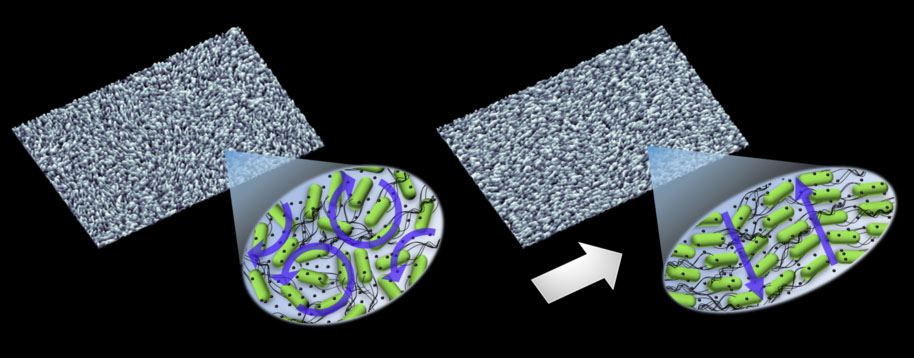| Jul 04, 2024 |
Getting bacteria into line
|
|
(Nanowerk News) Researchers at Finland’s Aalto University have found a way to use magnets to line up bacteria as they swim. The approach offers more than just a way to nudge bacteria into order – it also provides a useful tool for a wide range of research, such as work on complex materials, phase transitions and condensed matter physics.
|
|
The findings have been reported in Communications Physics ("Magnetically controlled bacterial turbulence").
|
|
Bacterial cells generally aren’t magnetic, so the magnets don’t directly interact with the bacteria. Instead, the bacteria are mixed into a liquid with millions of magnetic nanoparticles. This means the rod-shaped bacteria are effectively non-magnetic voids inside the magnetic fluid. When the magnets are switched on, creating a magnetic field, the bacteria are nudged to line up with the magnetic field because any other arrangement takes more energy – it’s harder to keep the rod-shaped holes at an angle to the magnetic field.
|
 |
| Magnetic nanoparticles are mixed with a dense bacterial suspension. Switching the uniform magnetic field on and off causes the system to transition between long-range orientational order and active turbulence. (Image: Kazusa Beppu / Aalto University)
|
|
‘We have managed to control perfectly regular Bacillus subtilis bacteria with magnetic fields. These bacteria are not magnetic, unlike some rare magnetotactic bacteria’, says assistant professor Jaakko Timonen who led the study.
|
|
‘In a nutshell, the most stable arrangement is for the bacterial “holes” to align with the magnetic field, resulting in a torque on the bacteria’s body, pushing them to line up,’ explains postdoctoral researcher Kazusa Beppu.
|
|
The strength of the magnetic field controls the alignment of the bacteria. When the magnets were off, the bacteria swam around haphazardly. As the researchers dialled up the strength of the magnetic field, the bacteria became more and more aligned, eventually swimming in nearly perfect rows.
|
|
The amount of bacteria also made a difference. When the population density was high, it took a stronger magnetic field to get the bacteria into alignment. That’s because the swimming bacteria affect the liquid in a way that’s similar to turbulence. When there are lots of bacteria, the turbulence-like effect is strong, and it takes a stronger magnetic field to overcome it.
|
|
‘The fluid flow created by bacteria in dense suspensions is called active turbulence because it contains structures characteristic to turbulent flows, such as vortices. However, it is important to understand that this so-called active turbulence is fundamentally different from the normal turbulence encountered for example in aviation”, clarifies Timonen.
|
|
Active turbulence is an extremely common phenomenon in nature. It’s caused by the combined actions of individual units, like cells that are swimming or moving about, ie. bacteria, sperm or epithelial cells. ‘Active turbulence is an important research topic in active matter physics, and the dense bacterial suspensions in our system are an excellent tool for studying it,’ says Beppu.
|
The micro-couriers of the future?
|
|
Ultimately, as fun as it sounds, this work isn’t just about getting bacteria to swim in an orderly fashion. The ability to control bacterial movement along with turbulent flow is important for understanding and manipulating active matter — materials in which dynamic patterns emerge from the behaviour of individual parts. Think flocks of birds, but on a cellular level.
|
|
The researchers envision applications around self-sustaining materials or harnessing the potential of microrobotics or biological engines to harvest energy or transport material. Targeted drug delivery could, for example, take place on a microscopic scale.
|
|
‘It’s exciting to be able to control active matter in a spatiotemporal and versatile manner over a space much larger than the size of individual active units,’ adds Beppu. ‘And because our method is versatile, it can be applied not only to bacterial systems but also to a variety of other systems, which will greatly advance the experimental study of active matter.’
|
|
The ability to fine-tune alignments in this way will also be an invaluable tool in other research domains, such as work on phase transitions or condensed matter physics. Meanwhile, the researchers plan to expand on their work by testing what happens when the magnetic field is dynamic – for example, with a rotating magnetic field. Beppu expects to see a rich variety of new phenomena in those experiments, adding that ‘understanding the magnetic controllability of orientation and flow is important for designing functional active materials.’
|

